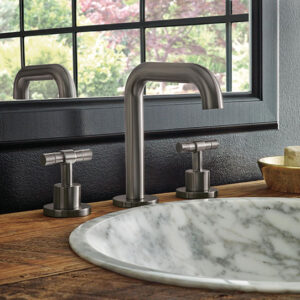Before receiving a place in a specification document, a faucet, shower system, or auto-dispenser must prove performance, technical qualification, and long-term service worth. All the way from documentation of compliance to lifecycle information, the process of evaluation is both analytical and experiential. To designers specifying commercial or institutional projects, each fixture has to support the design intent while meeting sustainability and operational needs.
Performance, Compliance, and Documentation
The process of evaluation starts with performance verification. Architects and consultants need concrete proof of conformance with ASME, CSA, and ADA standards and demand concise, well-organized technical documentation. A company that makes its data available proves credibility. BathSelect’s commercial faucet performance data library provides specifiers with exact flow rates, power supply details, and installation sizes—information that renders guesswork obsolete during submittal reviews. Likewise, FontanaShowers has a technical specification database with pressure diagrams and electrical plans that enhance proper MEP coordination. Such openness fosters trust and mitigates expensive clarifications on-site.
Design Consistency and Integrated Collections
Above and beyond compliance, architects appreciate design consistency among fixture families. Multiple restroom, guest room, or suite projects demand consistent visual language; thus, integrated product lines are crucial. An integrated faucet, shower, and dispenser product line offered by a manufacturer ensures a uniform look in a building. The Bravat Smart Sensor Series this design principle: a minimalist aesthetic, automated controls, and an adaptable finish palette that fits today’s hospitality spaces. Consistent fixture families also make procurement and specifications easier to write, such that what gets installed reflects the original design intent with no substitutions or finish mismatches.
Sustainability and Water Efficiency Evaluation
Architects today are being challenged more and more to comply with LEED, WELL Building Standard, and city efficiency requirements. EPA WaterSense-certified fixtures, low-flow aerators, or automatic shut-off sensors are now standard rather than optional. BathSelect’s sensor faucet efficiency series shows that regulated flow rates save without sacrificing user experience. Professionals tend to cross-check these figures using the EPA WaterSense fixture catalog or draw on Environmental Product Declarations where these exist. A company that issues sustainability information and materials transparency statements indicates a stronger commitment to environmental performance, a key factor for architects seeking LEED v4 or WELL accreditation for their buildings.
Digital Resources, BIM Support, and Technical Assistance
With digital modeling becoming a common practice, fixture manufacturers have to provide architects with pre-prepared design assets. It is possible to include proven models in Revit or AutoCAD, which reduces the coordination mistakes and makes documentation easier. FontanaShowers’ BIM resource center offers Revit families, CAD blocks, and downloadable spec sheets that are compatible with popular architectural software platforms. Less valuable is responsive technical support—producers with assigned architectural representatives who can confirm dimensions, mounting needs, or voltage compatibility enable companies to achieve aggressive deadlines. Prompt communication can make or break a brand’s position in the spec or switch out to a competitor.
Durability, Warranty Confidence, and Lifecycle Value
Reliability is a standard of measurement. Architects do not only compare initial cost but also service intervals, replacement part availability, and overall lifecycle cost. BathSelect’s commercial automatic faucet durability testing ensures products withstand hundreds of thousands of activation cycles, which ensures long-term performance in public settings. FontanaShowers’ hospital-grade hands-free line stresses mechanical longevity for high-traffic healthcare environments where downtime is not acceptable. Warranties extended and written endurance testing solidify trust that a brand’s assertions are substantiable. To large-scale property managers, a little extra upfront expense is worth it when maintenance savings and operational continuity are taken into account.
Material Quality and Finish Integrity
Material makeup continues to be the focus of architectural critique. Solid brass fixtures finished with sophisticated PVD coatings are corrosion-resistant and stay looking good over time. Physical samples are frequently requested by architects to test finish color and reflectivity in a range of lighting situations. The brushed nickel and matte black finish series from Bravat provides color depth consistency from collection to collection, which is perfect for hospitality, retail, and institutional design programs that require visual consistency. Long-term finish stability not only preserves brand reputation but also guarantees the product specified remains faithful to the architect’s design intent years after occupancy.
Case Studies, Peer Validation, and Evidence of Performance
Specification choices are also based on evidence from similar projects. Documented installations, case studies, and independent reports enable architects to verify advertising claims. BathSelect features an exhibition of commercial installations showing sensor performance and durability in airport toilets, while Bravat’s architectural project gallery
identifies actual uses in hospitality developments. Third-party sources like the AIA’s Product Specification Best Practices and Plumbing Manufacturers International research provide worthwhile paradigms for the comparison of product reliability and compliance from different manufacturers. Peer confirmation ensures that the designers’ specified products have operated effectively under equivalent operating conditions.
Post-Installation Service and Continuing Education
Even after the handover of the project, a brand’s level of engagement influences its reputation. Architects take note of how manufacturers handle warranty claims, field modifications, and replacement part logistics. Brands with architectural outreach programs and on-demand technical support receive repeat specification opportunities. FontanaShowers supports professionals through its architectural support program offering product integration guidance and AIA-approved educational materials. Continuing education strengthens relationships between design professionals and manufacturers, ensuring each specification is functional yet innovative.
Final Evaluation: Confidence Based on Established Value
Ultimately, architects evaluate fixture brands holistically through a field of technical integrity, sustainable performance, digital accessibility, and service dependability. The process isn’t aesthetic-driven—it’s evidence-based confidence. By linking up with systems like the WELL Building Standard and USGBC’s LEED credit system
and through the use of BIM-ready products made available by leading manufacturers, architects can ensure that each specified fitting delivers measurably to project quality and occupant well-being. By consistently upholding these professional standards, brands such as BathSelect, FontanaShowers, and Bravat go beyond product brochures to become trusted specification partners across the worldwide architectural fraternity.

No responses yet